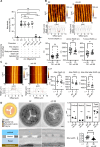Cuticular collagens mediate cross-kingdom predator-prey interactions between trapping fungi and nematodes
- PMID: 40591707
- PMCID: PMC12237271
- DOI: 10.1371/journal.pbio.3003178
Cuticular collagens mediate cross-kingdom predator-prey interactions between trapping fungi and nematodes
Abstract
Adhesive interactions, mediated by specific molecular and structural mechanisms, are fundamental to host-pathogen and predator-prey relationships, driving evolutionary dynamics and ecological interactions. Here, we investigate the cellular and molecular basis of adhesion between the nematode Caenorhabditis elegans and its natural predator, the nematode-trapping fungus Arthrobotrys oligospora, which employs specialized adhesive nets to capture its prey. Using forward genetic screens, we identified C. elegans mutants that escape fungal traps and revealed the nuclear hormone receptor NHR-66 as a key regulator of fungal-nematode adhesion. Loss-of-function mutations in nhr-66 conferred resistance to fungal trapping through the downregulation of a large subset of cuticular collagen genes. Restoring collagen gene expression in nhr-66 mutants abolished the escape phenotype, highlighting the essential role of these structural proteins in fungal-nematode adhesion. Furthermore, sequence analysis of natural C. elegans populations revealed no obvious loss-of-function variants in nhr-66, suggesting selective pressures exist that balance adhesion-mediated predation risk with physiological robustness. We observed that loss of nhr-66 function resulted in a trade-off of increased hypersensitivity to hypoosmotic stress and cuticular fragility. These findings underscore the pivotal role of structural proteins in shaping ecological interactions and the evolutionary arms race between predator and prey.
Copyright: © 2025 Chang et al. This is an open access article distributed under the terms of the Creative Commons Attribution License, which permits unrestricted use, distribution, and reproduction in any medium, provided the original author and source are credited.
Conflict of interest statement
The authors have declared that no competing interests exist.
Figures





Update of
-
Key processes required for the different stages of fungal carnivory by a nematode-trapping fungus.PLoS Biol. 2023 Nov 21;21(11):e3002400. doi: 10.1371/journal.pbio.3002400. eCollection 2023 Nov. PLoS Biol. 2023. Update in: PLoS Biol. 2025 Jul 1;23(7):e3003178. doi: 10.1371/journal.pbio.3003178. PMID: 37988381 Free PMC article. Updated.
References
-
- Thorn RG, Barron GL. Carnivorous mushrooms. Science. 1984;224(4644):76–8. - PubMed
-
- Yang C-T, Vidal-Diez de Ulzurrun G, Gonçalves AP, Lin H-C, Chang C-W, Huang T-Y, et al. Natural diversity in the predatory behavior facilitates the establishment of a robust model strain for nematode-trapping fungi. Proc Natl Acad Sci U S A. 2020;117(12):6762–70. doi: 10.1073/pnas.1919726117 - DOI - PMC - PubMed
MeSH terms
Substances
Supplementary concepts
LinkOut - more resources
Full Text Sources

